.
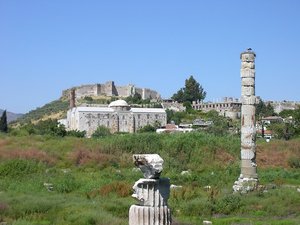 \
\
The site of the Temple of Artemis at Ephesus in today Turkey: Some stacked remnants recreate columns, but nothing remains of the original temple
The Temple of Artemis also called Artemision in Greek, and Artemisium in Latin (440 BC, at Ephesus (present day Turkey)), figured in the classic lists of the Seven Wonders of the World drawn up in Alexandria. It took 120 years to build, and was started by King Croesus of Lydia. Scarcely anything remains at the site.
As described by Antipater of Sidon; who compiled a list of the Seven Wonders:
"I have set eyes on the wall of lofty Babylon on which is a road for chariots, and the statue of Zeus by the Alpheus, and the hanging gardens, and the colossus of the Sun, and the huge labour of the high pyramids, and the vast tomb of Mausolus; but when I saw the house of Artemis that mounted to the clouds, those other marvels lost their brilliancy, and I said, 'Lo, apart from Olympus, the Sun never looked on aught so grand."
Antipater, Greek Anthology (IX.58)
Location
The Temple of Artemis was located in the ancient city of Ephesus, about 50 km south from modern port city of Izmir, in Turkey. Like the other wonders, Antipater chose the temple for his list not because of its beauty or size, but rather because it rested near the border of the Greek world. This inspired a sense of mystery and awe for the Greeks, and emphasized Alexander the Great's vast empire.
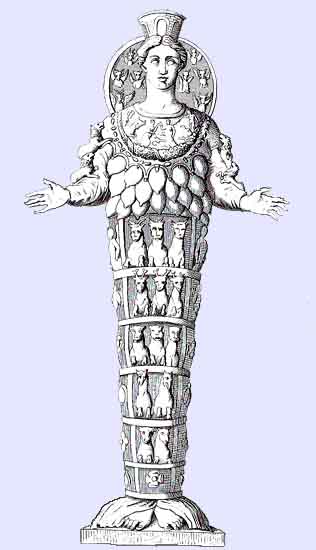
Ephesian Artemis
Artemis was the Greek goddess, the virginal huntress and twin of Apollo, who supplanted the Titan Selene as Goddess of the Moon. Of the Olympian goddesses who inherited aspects of the Great Goddess of Crete, Athene was more honored than Artemis at Athens. At Ephesus a goddess whom the Greeks associated with Artemis was passionately venerated in an archaic, certainly pre-Hellenic icon (illustration, right). The original was carved of wood, with many breasts denoting her fertility, rather than the virginity that Hellene Artemis assumed. Most like Near Eastern and Egyptian deities and least like Greek ones, her body and legs are enclosed within a tapering pillar-like term, from which her feet protrude. On the coins minted at Ephesus, the many-breasted Goddess wears a mural crown (like a city's walls), an attribute of Cybele. She rests either arm on a staff formed of entwined serpents or of a stack of ouroboroi the eternal serpent with its tail in its mouth. Like Cybele, the goddess at Ephesus was served by hierodules called megabyzae, and by maidens (korai).
A votive inscription mentioned by Bennett (see link), which dates probably from about the 3rd century BC, associates Ephesian Artemis with Crete: "To the Healer of diseases, to Apollo, Giver of Light to mortals, Eutyches has set up in votive offering (a statue of) the Cretan Lady of Ephesus, the Light-Bearer."
The Greek habits of syncretism assimilated all foreign gods under some form of the Olympian pantheon familiar to them, and it is clear that at Ephesus, the identification the Ionian settlers made with Artemis was slender.
The Temple of Artemis, as imagined in this hand-coloured engraving by Martin Heemskerck (1498 - 1574), has the "old-fashioned" look of Santa Maria Novella in Florence and other Italian quattrocento churches of the previous generation.
History
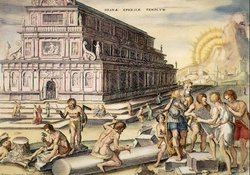
The Temple of Artemis, as imagined in this hand-coloured engraving by Martin Heemskerck (1498 - 1574), has the "old-fashioned" look of Santa Maria Novella in Florence and other Italian quattrocento churches of the previous generation.
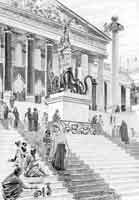
The sacred site at Ephesus was far older than the Artemisium. Pausanias understood the shrine of Artemis there to be very ancient. He states with certainty that it antedated the Ionic immigration by many years, being older even than the oracular shrine of Apollo at Didymi. He said that the pre-Ionic inhabitants of the city were Leleges and Lydians.
The Temple was designed by the Greek architect Chersiphron, and built around 550 BC at the expense of Croesus, the wealthy king of Lydia. Marshy ground was selected for the building site as a precaution against future earthquakes (Pliny). The temple became a tourist attraction, visited by merchants, kings, and sightseers, many of whom paid homage to Artemis in the form of jewelry and various goods. Its splendor also attracted many worshippers, many of whom formed the cult of Artemis.
The temple was a widely respected place of refuge, a tradition that was linked in myth with the Amazons who took refuge there, both from Heracles and from Dionysus.
The temple of Artemis at Ephesus was destroyed on July 21, 356 BC in an act of arson committed by Herostratus. According to the story, his motivation was fame at any cost, thus the term herostratic fame.
"A man was found to plan the burning of the temple of Ephesian Diana so that through the destruction of this most beautiful building his name might be spread through the whole world." ( Valerius Maximus, VIII.14.ext.5 (http://penelope.uchicago.edu/Thayer/L/Roman/Texts/Valerius_Maximus/8*.html#14.ext.5)])
The Ephesians, outraged, announced that Herostratus' name never be recorded. Strabo later noted the name, which is how we know today.
That very same night, Alexander the Great was born. Plutarch remarked that Artemis was too preoccupied with Alexander's delivery to save her burning temple. Alexander later offered to pay for the Temple's rebuilding, but the Ephesians refused. Eventually, the temple was restored after Alexander's death, in 323 BC.
The reconstruction of the great Temple of Artemis was again destroyed during a raid by the Goths in AD 262, in the time of emperor Gallienus "Respa, Veduc and Thuruar, leaders of the Goths, took ship and sailed across the strait of the Hellespont to Asia. There they laid waste many populous cities and set fire to the renowned temple of Diana at Ephesus", reported Jordanes in Getica (xx.107).
Over the next two centuries, the majority of Ephesians converted to Christianity, and the Temple of Artemis lost its religious appeal. Christians tore down the remenants of the temple, and the stones were used in construction of other buildings.
The main primary sources for the Temple of Artemis at Ephesus are in Pliny, Natural History XXXVI.xxi.95; Pomponius Mela, i:17; Plutarch's Life of Alexander, III.5 (the burning of the Artemisium).
The site of the temple was rediscovered in 1869 by an expedition sponsored by the British Museum, and several artifacts and sculptures from the reconstructed temple, though not the lost Wonder of the World, can be seen there today. Today, a single column from the Temple of Artemis remains.
Architecture and Art
Most of the physical description and art within the Temple of Artemis comes from Pliny, though there are different accounts and the actual size varies.
Pliny describes the temple as 377 feet long and 180 feet wide made almost entirely of marble. The Temple consists of 127 columns, each 60 feet in height; many of which were carved decoratively. The columns were Ionic in style.
The Temple of Artemis housed many fine artworks. Sculptures by renowned Greek sculptors Polyclitus, Pheidias, Cresilas, and Phradmon adorned the temple, as well as paintings and gilded columns of gold and silver. The sculptors often competed at creating the finest sculpture. Many of these sculptures were of Amazons, who are said to have founded the city of Ephesus.
Pliny tells us that Scopas worked carved reliefs into the temple's columns, who also worked on the Mausoleum of Mausollos.
 .
.
Cult and Influence
The Temple of Artemis was located at an economically robust region, seeing merchants and travellers from all over Asia Minor. The temple was influenced by many beliefs, and can be seen as a symbol of faith for many different peoples. The Ephesians worshipped Cybele, and incorporated many of their beliefs into the worship of Artemis. Artemis-Cybele became quite contrasted from her Roman counterpart, Diana. The cult of Artemis attracted thousands of worshippers from far-off lands. They would all gather at the site and worship her.
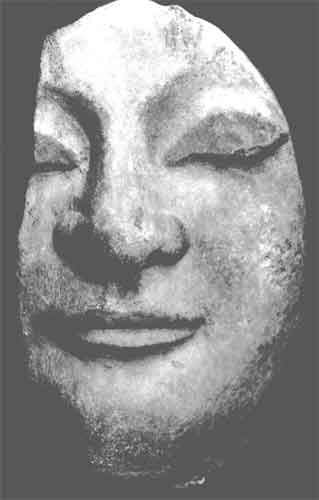
Woman or goddess from the Artemis Temple, c. 550 BC


